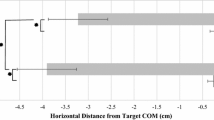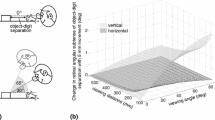Abstract
The perceived distance of objects is biased depending on the distance from the observer at which objects are presented, such that the egocentric distance tends to be overestimated for closer objects, but underestimated for objects further away. This leads to the perceived depth of an object (i.e., the perceived distance from the front to the back of the object) also being biased, decreasing with object distance. Several studies have found the same pattern of biases in grasping tasks. However, in most of those studies, object distance and depth were solely specified by ocular vergence and binocular disparities. Here we asked whether grasping objects viewed from above would eliminate distance-dependent depth biases, since this vantage point introduces additional information about the object’s distance, given by the vertical gaze angle, and its depth, given by contour information. Participants grasped objects presented at different distances (1) at eye-height and (2) 130 mm below eye-height, along their depth axes. In both cases, grip aperture was systematically biased by the object distance along most of the trajectory. The same bias was found whether the objects were seen in isolation or above a ground plane to provide additional depth cues. In two additional experiments, we verified that a consistent bias occurs in a perceptual task. These findings suggest that grasping actions are not immune to biases typically found in perceptual tasks, even when additional cues are available. However, online visual control can counteract these biases when direct vision of both digits and final contact points is available.





Similar content being viewed by others
References
Bozzacchi, C., Brenner, E., Smeets, J. B., Volcic, R., & Domini, F. (2018). How removing visual information affects grasping movements. Experimental Brain Research, 236, 985–995. https://doi.org/10.1007/s00221-018-5186-6.
Bozzacchi, C., & Domini, F. (2015). Lack of depth constancy for grasping movements in both virtual and real environments. Journal of Neurophysiology, 114(4), 2242–2248. http://doi.org/http://dx.doi.org/ https://doi.org/10.1152/jn.00350.2015.
Bozzacchi, C., Volcic, R., & Domini, F. (2014). Effect of visual and haptic feedback on grasping movements. Journal of Neurophysiology, 112(12), 3189–3196. https://doi.org/10.1152/jn.00439.2014.
Bozzacchi, C., Volcic, R., & Domini, F. (2016). Grasping in absence of feedback: systematic biases endure extensive training. Experimental Brain Research, 234, 255–265. https://doi.org/10.1007/s00221-015-4456-9.
Brenner, E., & Smeets, J. B. J. (1997). Fast responses of the human hand to changes in target position. Journal of Motor Behavior, 29(4), 297–310.
Brenner, E., & Van Damme, W. J. M. (1999). Perceived distance, shape and size. Vision Research, 39(5), 975–986. https://doi.org/10.1016/S0042-6989(98)00162-X.
Campagnoli, C., Croom, S., & Domini, F. (2017). Stereovision for action reflects our perceptual experience of distance and depth. Journal of Vision, 17(9), 1–26. https://doi.org/10.1167/17.9.21.doi.
Campagnoli, C., & Domini, F. (2016). Conscious perception and grasping rely on a shared depth encoding. Journal of Vision, 16, 449. https://doi.org/10.1167/16.12.449.
Campagnoli, C., & Domini, F. (2018). Depth-cue combination yields identical biases in perception and grasping. Manuscript submitted for publication.
Chen, J., Sperandio, I., & Goodale, M. A. (2018). Proprioceptive distance cues restore perfect size constancy in grasping, but not perception, when vision is limited. Current Biology. https://doi.org/10.1016/j.cub.2018.01.076.
Domini, F., & Caudek, C. (2013). Perception and action without veridical metric reconstruction: An affine approach. In Shape perception in human and computer vision (pp. 285–298). London: Springer.
Foley, J. M. (1980). Binocular distance perception. Psychological Review, 87(5), 411–434. https://doi.org/10.1037/h0021465.
Franz, V. H. (2003). Manual size estimation: a neuropsychological measure of perception? Experimental Brain Research, 151, 471–477.
Fukui, T., & Inui, T. (2006). The effect of viewing the moving limb and target object during the early phase of movement on the online control of grasping. Human Movement Science, 25, 349–371. https://doi.org/10.1016/j.humov.2006.02.002.
Gardner, P. L., & Mon-Williams, M. (2001). Vertical gaze angle: Absolute height-in-scene information for the programming of prehension. Experimental Brain Research, 136(3), 379–385. https://doi.org/10.1007/s002210000590.
Glover, S., & Dixon, P. (2002). Dynamic effects of the Ebbinghaus illusion in grasping: Support for a planning/control model of action. Perception & Psychophysics, 64(2), 266–278.
Goodale, M. A. (2011). Transforming vision into action. Vision Research, 51(13), 1567–1587.
Goodale, M. A., & Milner, A. D. (1992). Separate visual pathways for perception and action. Trends in Neurosciences, 15(1), 20–25.
Greenwald, H. S., Knill, D. C., & Saunders, J. A. (2005). Integrating visual cues for motor control: A matter of time. Vision Research, 45, 1975–1989. https://doi.org/10.1016/j.visres.2005.01.025.
Heath, M., Rival, C., & Binsted, G. (2004). Can the motor system resolve a premovement bias in grip aperture? Online analysis of grasping the Müller-Lyer illusion. Experimental Brain Research, 158, 378–384. https://doi.org/10.1007/s00221-004-1988-9.
Hibbard, P. B., & Bradshaw, M. F. (2003). Reaching for virtual objects: Binocular disparity and the control of prehension. Experimental Brain Research, 148(2), 196–201. https://doi.org/10.1007/s00221-002-1295-2.
Higashiyama, A., & Ueyama, E. (1988). The perception of vertical and horizontal distances in outdoor settings. Perception & Psychophysics, 44(2), 151–156. https://doi.org/10.3758/BF03208707.
Jakobson, L. S., & Goodale, M. A. (1991). Factors affecting higher-order movement planning: a kinematic analysis of human prehension. Experimental Brain Research, 86(1), 199–208. https://doi.org/10.1007/BF00231054.
Jeannerod, M. (1984). The timing of natural prehension movements. Journal of Motor Behavior, 16(3), 235–254.
Jeannerod, M. (1986). The formation of finger grip during prehension. A cortically mediated visuomotor pattern. Behavioural Brain Research, 19, 99–116.
Johnston, E. B. (1991). Systematic distortions of shape from stereopsis. Vision Research, 31, 1351–1360. https://doi.org/10.1016/0042-6989(91)90056-B.
Keefe, B. D., Hibbard, P. B., & Watt, S. J. (2011). Depth-cue integration in grasp programming: No evidence for a binocular specialism. Neuropsychologia, 49, 1246–1257. https://doi.org/10.1016/j.neuropsychologia.2011.02.047.
Keefe, B. D., & Watt, S. J. (2017). Viewing geometry determines the contribution of binocular vision to the online control of grasping. Experimental Brain Research. https://doi.org/10.1007/s00221-017-5087-0.
Kopiske, K. K., & Domini, F. (2018). On the response function and range dependence of manual estimation. Experimental Brain Research, 236, 1309–1320. https://doi.org/10.1007/s00221-018-5223-5.
Marotta, J. J., & Goodale, M. A. (1998). The role of learned pictorial cues in the programming and control of grasping. Experimental Brain Research, 121, 465–470. https://doi.org/10.1007/s002210050482.
Melmoth, D. R., & Grant, S. (2006). Advantages of binocular vision for the control of reaching and grasping. Experimental Brain Research, 171(3), 371–388. https://doi.org/10.1007/s00221-005-0273-x.
Melmoth, D. R., Storoni, M., Todd, G., Finlay, A. L., & Grant, S. (2007). Dissociation between vergence and binocular disparity cues in the control of prehension. Experimental Brain Research, 183(3), 283–298. https://doi.org/10.1007/s00221-007-1041-x.
Mon-Williams, M., McIntosh, R. D., & Milner, A. D. (2001). Vertical gaze angle as a distance cue for programming reaching: Insights from visual form agnosia II (of III). Experimental Brain Research, 139(2), 137–142. https://doi.org/10.1007/s002210000658.
Nicolini, C., Fantoni, C., Mancuso, G., Volcic, R., & Domini, F. (2014). A framework for the study of vision in active observers. In B. Rogowitz, T. Pappas, & H. de Ridder (eds.), Proceedings of the SPIE (Vol. 9014, p. 901414). San Francisco. https://doi.org/10.1117/12.2045459.
Norman, J. F., Todd, J. T., Perotti, V. J., & Tittle, J. S. (1996). The visual perception of three-dimensional length. Journal of Experimental Psychology: Human Perception and Performance, 22(1), 173–186. https://doi.org/10.1037/0096-1523.22.1.173.
R Core Team. (2015). R: A language and environment for statistical computing. Vienna, Austria: R Foundation for Statistical Computing. https://www.r-project.org.
Servos, P. (2000). Distance estimation in the visual and visuomotor systems. Experimental Brain Research, 130, 35–47. https://doi.org/10.1007/s002210050004.
Servos, P., Goodale, M. A., & Jakobson, L. S. (1992). The role of binocular vision in prehension: A kinematic analysis. Vision Research, 32(8), 1513–1521.
Smeets, J. B. J., & Brenner, E. (1999). A new view on grasping. Motor Control, 3(3), 237–271.
Snow, J. C., Pettypiece, C. E., McAdam, T. D., McLean, A. D., Stroman, P. W., Goodale, M. A., & Culham, J. C. (2011). Bringing the real world into the fMRI scanner: Repetition effects for pictures versus real objects.. Scientific Reports, 1, 1–10. https://doi.org/10.1038/srep00130.
Verheij, R., Brenner, E., & Smeets, J. B. J. (2012). Grasping kinematics from the perspective of the individual digits: A modelling study. PLoS ONE, 7(3), e33150. https://doi.org/10.1371/journal.pone.0033150.
Volcic, R., & Domini, F. (2016). On-line visual control of grasping movements. Experimental Brain Research, 234, 2165–2177. https://doi.org/10.1007/s00221-016-4620-x.
Volcic, R., Fantoni, C., Caudek, C., Assad, J. A., & Domini, F. (2013). Visuomotor adaptation changes stereoscopic depth perception and tactile discrimination. Journal of Neuroscience, 33(43), 17081–17088. https://doi.org/10.1523/JNEUROSCI.2936-13.2013.
Wallach, H., & O’Leary, A. (1982). Slope of regard as a distance cue. Perception & Psychophysics, 31(2), 145–148. https://doi.org/10.3758/BF03206214.
Whitwell, R. L., & Goodale, M. A. (2013). Grasping without vision: Time normalizing grip aperture profiles yields spurious grip scaling to target size. Neuropsychologia, 51(10), 1878–1887. https://doi.org/10.1016/j.neuropsychologia.2013.06.015.
Author information
Authors and Affiliations
Corresponding author
Ethics declarations
Conflict of interest
Chiara Bozzacchi declares that she has no conflict of interest. Karl K. Kopiske declares that he has no conflict of interest. Robert Volcic declares that he has no conflict of interest. Fulvio Domini declares that he has no conflict of interest. Ethical approval: All procedures performed involving human participants were in accordance with the ethical standards of the institutional research committee (Comitato Etico per la Sperimentazione con l’Essere Vivente of the University of Trento) and with the 1964 Helsinki declaration and its later amendments or comparable ethical standards. Informed consent: Informed consent was obtained from all individual participants included in the study. Some of data described here have also been presented at the 2018 European Conference on Visual Perception.
Rights and permissions
About this article
Cite this article
Kopiske, K.K., Bozzacchi, C., Volcic, R. et al. Multiple distance cues do not prevent systematic biases in reach to grasp movements. Psychological Research 83, 147–158 (2019). https://doi.org/10.1007/s00426-018-1101-9
Received:
Accepted:
Published:
Issue Date:
DOI: https://doi.org/10.1007/s00426-018-1101-9




